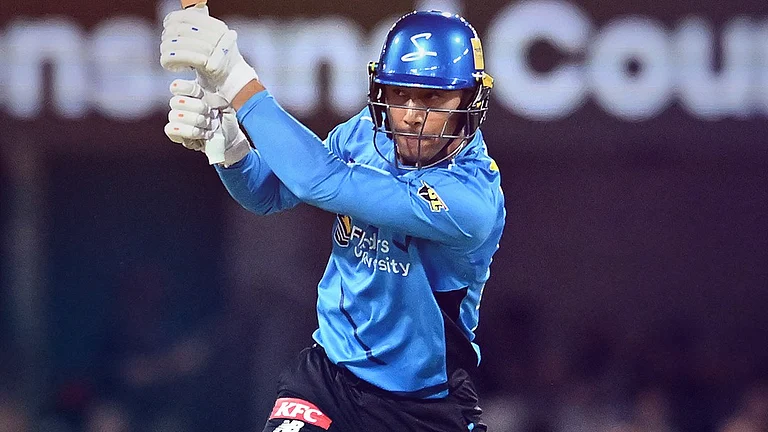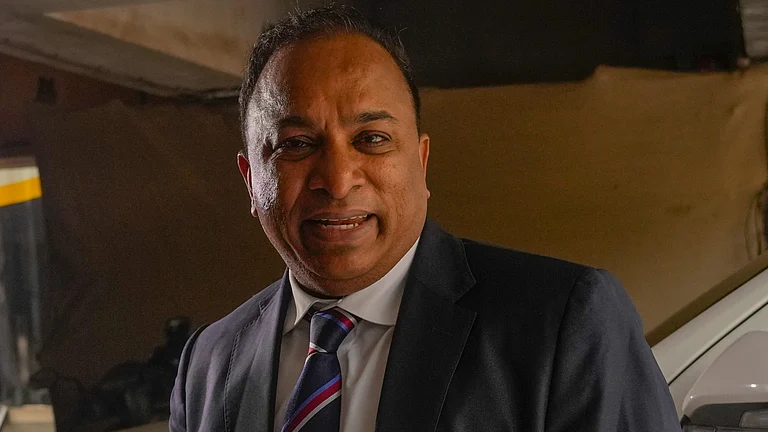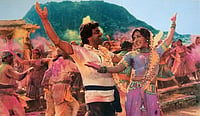I was seven years old when Nehru died in 1964. Like thousands of other parents, mine took their children to watch his cortege pass. It didn't occur to them to leave the children at home; it never crossed our minds, my brother's and mine, that we shouldn't go. Panditji had died—it was the ordinary thing to do. I don't recall feeling sad or being particularly moved—I don't even have a memory of his cortege—but I remember I was reading The Rub-a-dub Mystery in hard covers. It was only the second novel I had read without help. I don't think I would have as clear a memory of it if my parents hadn't taken us along to see off Nehru.
Nehru had another seven years of half-life till the Bangladesh War finished him off. Mrs Gandhi completed her makeover into Shakti and emerged with an aura of her own, a fluorescent calendar art aura that soon became radioactive with Pokharan, the nuclear explosion for peaceful purposes in 1974. Luckily, the India that I took for granted as children do, the country that supplied the scenery for my life, was wholly formed in my head by the time the Sixties ended—and the Sixties belonged to Nehru alive or dead.
Historically, the Sixties are no more important than any other decade in the 50-year span of independent India, but they are important for my generation because they defined the Republic and its life in permanent ways. We were taught to be secular but errantry and the objects of our gallantry, our damsels in distress were Muslims. It remained an unconsummated chivalry because there were few Muslims in middle-class metropolitan schools. I went to a Jesuit school in Old Delhi (I mention this because Old Delhi had and still has a substantial Muslim population), and in the 12 years I was there I can't remember coming across a single Muslim name. Whether this was on account of an anti-Muslim bias, the smallness of the Muslim middle-class or its diffidence, I don't know. but I do know that it was typical of Nehruvian India. Fine first principles, zero follow up—a bit like school science exams where cramming theory for the written papers was the tough part but the practicals were easy because no one took them seriously and invigilators let you cheat.
The only place you were sure of meeting Muslims was the movies. Waheeda Rehman, Dilip Kumar, Saira Bano, Johnny Walker, Mumtaz, Farida Jalal, Mehmood.... The films they starred in were called Hindi movies, which was odd because Hindi's hegemons, the conscience-keepers of the new Republic, saw in the dil, khoon and kismat idiom of Hindi cinema the sinister hand of Urdu. Actually, Sanskritised sarkari Hindi did about as well or badly as Nehruvian secularism. It had the patronage of the State, it supplied the vocabulary that Akashvani used to encrypt its news bulletins and it was the language of Saral Bhasha, my Hindi textbook. Practically, it was a bit like the science tests: everyone laughed at the Hindi news (ab aap samachar mein Hindi suniye—please listen to Hindi on the news), in my Jesuit school we were forbidden to speak Hindi outside of Hindi
class, and at home, weekly copies of Parag and Chandamama piled up unread. My mother didn't stop subscribing to them though: she thought printed Devanagari was a virus that, delivered often enough, would infect her children with Hindi.
The Hindi we consumed willingly was the dialogue and lyrics of the movies we saw in Minerva, Golcha and Ritz. Independent India's sole success in the area of shared nationhood is the Hindi film: it's the only thing Indians voluntarily have in common. In England, repertory the-atre was the cultural engine that supplied other media like television and film; India's popular culture was and is powered by the Bombay film. It is the only cultural product that has a pan-Indian market—it transcends regional, linguistic and religious identities in both its personnel and its consumers. It is eclectic, unsubsidised and entirely secular if only because, as Manmohan Desai cannily observed, Muslims are a large part of the "repeat audience", ie, paying customers who see movies they like more than once and make them hits.
It doesn't surprise me that Rushdie and Sealy and Tharoor have written novels that draw largely on Bollywood for their inspiration or that Vikram Chandra loves Sholay, admires Govinda and has a credit for 1942: A Love Story. The Anglophone Indian who enjoys Hindi cinema is likely to use it in his fiction because it is something he has in common with his countrymen in an unforced way. The middle class writer (and nearly all writers are middle class, not just the ones who write in English), keenly aware of the privileges that separate him from the majority of his fellow citizens, finds in Bombay's cinema a world he shares with millions of Indians without self-consciousness or condescension. His use of this world doesn't always result in good fiction, but it is an acknowledgement of the constitutive influence of Hindi cinema on Independent India. On the other hand, Hindi-wallahs and our cultural commissars, those tireless promoters of sub-sidised art and the authentically purged vernacular, loathe the Hindi film's shrewd eclecticism and its ability to pay its own way.
The other incubator of national feeling in independent India was cricket. Cinema and cricket...the reader born after 1970 might conclude that post-colonial nationalism is a spectator sport. And he would be nearly right: India exploding in firecrackers when the World Cup was won in 1983, pan-Indian despair after Miandad's sixer in Sharjah, India rampant in the quarter finals of the last World Cup when its team beat Pakistan in Bangalore and a hundred million virile couch potatoes pumped their fists. Nothing knits the nation together like televised one-day cricket, specially if it features that 50-year-old enemy born of independence, Pakistan.
But for someone who was seven when Nehru died, cricketing nationalism was (naturally) a different, better, nobler thing. Cricket-induced patriotism in the Sixties was good nationalism because it had to be earned: earned by reading the sports pages and Sports and Pastime, by listening to the radio (Chakrapani and Pearson Surita, John Arlott and Alan Mcgilray, Lindsay Hassett and Trevor Bailey, Radio Australia and Test Match Special, even the unspeakable Vizzy), by queuing to watch Pataudi bat, and above all else, by playing cricket no matter how badly, by oiling bats, polishing leather and dreaming of English willow. Kashmir willow was okay too.
THERE were three reasons for the virtuous, satvik nationalism inspired by cricket in the Sixties and early Seventies. One, we had stopped playing Pakistan by the time I began rooting for the Indian team because of the '65 war. In the absence of the enemy, winning or losing brought happiness or disappointment not blood-gorged hysteria or limp despair. Two, there was no one-day cricket: the placid rhythms of five-day Tests that ended, more often than not, in draws, supplied few climaxes and demanded initiated followers. Finally, cricket wasn't televised till the mid-Seventies.
Till then spectatorship was driven by an involvement with the game and patriotic exultation was just one fragrance in a complex bouquet. Once instant cricket became instantly available, cricket's audience expanded hugely to take in people whose interest in the game was somewhat incidental: televised one-day matches exist to give network audiences a quick fix of nationalist excitement and advertisers more mugs for their money.
Still, both before television and after, cricket remained an important advertisement for a secular nation. For a start, like the movies, it was a place where you met Muslims. And Christians and Parsees and Sikhs. The importance of captains Pataudi and Azharuddin as symbols of a plural India was enormous, much greater than the symbolic importance of Muslim presidents, vice-presidents and governors because political appointments are sometimes read as a mere tokenism but no one in his right mind has ever argued that Pataudi was made captain to advance India's secular claims. I'm a historian by training but I know that in the great wrestling match with that tireless hydra, Bharat Kesri Bal Krishna Thakani, Kirmani would be a better bet than Kosambi. Also, the cricket team of the late Sixties that included Bishen Bedi, Farokh Engineer, Abid Ali and Mansur Ali Khan Pataudi did more to bear witness to a composite nation than all the secular histories ever written.
But to see Pataudi wholly or even mainly as a secular mascot is to diminish him. The thing about Independent India's pre-television heroes was that they were mythical. We knew through word of mouth and faith that Dara Singh had become the Champion of the World by rolling King Kong over, just as we knew that Pataudi had a glass eye. In the normal course, 203 not out was wonderful. With a glass eye it became fabulous. Had Pataudi been playing today we would have been shown (on Spin Vision); that his eye was damaged not glazed and that faintly piratical charisma would have vanished. We knew Pataudi solely for his cricket (the one time he stood for election he lost his deposit) and so for those of us who were seven in 1964, the Nawab remains a cavalier ghost from a carefree past. Later heroes, unfortunately, returned to haunt us as television commentators.
Actually, the Sixties were a pretty feeble Golden Age. The two wars (three if you count Goa) and the Bihar famine put the skids under the Planned Economy and if you look at the figures, we won very little under Pataudi. A decade that saw starvation, military humiliation, the enthronement of Mrs Gandhi, the consolidation of the license raj and Rajesh Khanna as our first superstar, doesn't have much to be proud of. But it was, at worst, a time marked by bad judgement, bad policy and bungling—not irrational, bestial cruelty. I'm glad I wasn't seven in 1984.
























